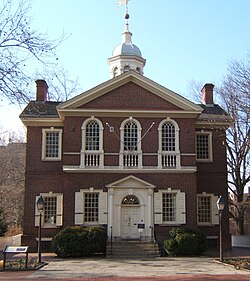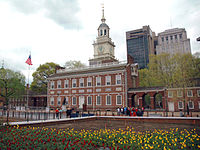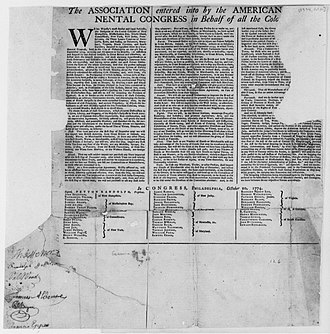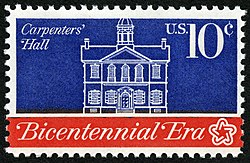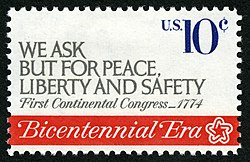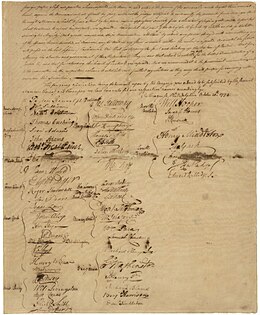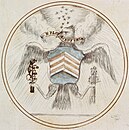Convention
The Congress met from September 5 to October 26, 1774, in Carpenters' Hall in Philadelphia with delegates from 12 of the Thirteen Colonies participating. The delegates were elected by the people of the respective colonies, the colonial legislature, or by the Committee of Correspondence of a colony. [2] Loyalist sentiments outweighed Patriot views in Georgia, leading that colony to not immediately join the revolutionary cause until the following year when it sent delegates to the Second Continental Congress. [3]
Peyton Randolph was elected as president of the Congress on the opening day, and he served through October 22 when ill health forced him to retire, and Henry Middleton was elected in his place for the balance of the session. Charles Thomson, leader of the Philadelphia Committee of Correspondence, was selected as the congressional secretary. [4] The rules adopted by the delegates were designed to guard the equality of participants and to promote free-flowing debate. [2]
As the deliberations progressed, it became clear that those in attendance were not of one mind concerning why they were there. Conservatives such as Joseph Galloway, John Dickinson, John Jay, and Edward Rutledge believed their task to be forging policies to pressure Parliament to rescind its unreasonable acts. Their ultimate goal was to develop a reasonable solution to the difficulties and bring about reconciliation between the Colonies and Great Britain. Others such as Patrick Henry, Roger Sherman, Samuel Adams, and John Adams believed their task to be developing a decisive statement of the rights and liberties of the Colonies. Their ultimate goal was to end what they felt to be the abuses of parliamentary authority and to retain their rights, which had been guaranteed under Colonial charters and the English constitution. [5]
Roger Sherman denied the legislative authority of Parliament, and Patrick Henry believed that the Congress needed to develop a completely new system of government, independent from Great Britain, for the existing Colonial governments were already dissolved. [6] In contrast to these ideas, Joseph Galloway put forward a "Plan of Union" which suggested that an American legislative body should be formed with some authority, whose consent would be required for imperial measures. [6] [7]
Accomplishments
The primary accomplishment of the First Continental Congress was a compact among the colonies to boycott British goods beginning on December 1, 1774, unless parliament should rescind the Intolerable Acts. [9] While delegates convened in the First Continental Congress, fifty-one women in Edenton, North Carolina formed their own association (now referred to as the Edenton Tea Party) in response to the Intolerable Acts that focused on producing goods for the colonies. [10] Additionally, Great Britain's colonies in the West Indies were threatened with a boycott unless they agreed to non-importation of British goods. [11] Imports from Britain dropped by 97 percent in 1775, compared with the previous year. [9] Committees of observation and inspection were to be formed in each Colony to ensure compliance with the boycott. It was further agreed that if the Intolerable Acts were not repealed, the colonies would also cease exports to Britain after September 10, 1775. [9]
The Houses of Assembly of each participating colony approved the proceedings of the Congress, with the exception of New York. [12] The boycott was successfully implemented, but its potential for altering British colonial policy was cut off by the outbreak of hostilities in April 1775.
Congress also voted to meet again the following year if their grievances were not addressed satisfactorily. Anticipating that there would be cause to convene a second congress, delegates resolved to send letters of invitation to those colonies that had not joined them in Philadelphia, including Quebec, Saint John's Island (now Prince Edward Island), Nova Scotia, Georgia, East Florida, and West Florida. [13] Of these, only Georgia would ultimately send delegates to the next Congress.

The Continental Congress was a series of legislative bodies, with some executive function, for the Thirteen Colonies of Great Britain in North America, and the newly declared United States before, during, and after the American Revolutionary War. The Continental Congress refers to both the First and Second Congresses of 1774–1781 and at the time, also described the Congress of the Confederation of 1781–1789. The Confederation Congress operated as the first federal government until being replaced following ratification of the U.S. Constitution. Until 1785, the Congress met predominantly at what is today Independence Hall in Philadelphia, though it was relocated temporarily on several occasions during the Revolutionary War and the fall of Philadelphia.

Joseph Hewes was an American Founding Father and a signer of the Continental Association and U.S. Declaration of Independence. Hewes was a native of Princeton, New Jersey, where he was born in 1730. His parents were members of the Society of Friends, commonly known as Quakers. Early biographies of Hewes falsely claim that his parents came from Connecticut. Hewes may have attended the College of New Jersey, known today as Princeton University but there is no record of his attendance. He did, in all probability, attend the grammar school set up by the Stonybrook Quaker Meeting near Princeton.

The Intolerable Acts, sometimes referred to as the Insufferable Acts or Coercive Acts, were a series of five punitive laws passed by the British Parliament in 1774 after the Boston Tea Party. The laws aimed to punish Massachusetts colonists for their defiance in the Tea Party protest of the Tea Act, a tax measure enacted by Parliament in May 1773. In Great Britain, these laws were referred to as the Coercive Acts. They were a key development leading to the outbreak of the American Revolutionary War in April 1775.

The Second Continental Congress was the late-18th-century meeting of delegates from the Thirteen Colonies that united in support of the American Revolution and its associated Revolutionary War, which established American independence from the British Empire. The Congress constituted a new federation that it first named the United Colonies, and in 1776, renamed the United States of America. The Congress began convening in Philadelphia, on May 10, 1775, with representatives from 12 of the 13 colonies, after the Battles of Lexington and Concord.
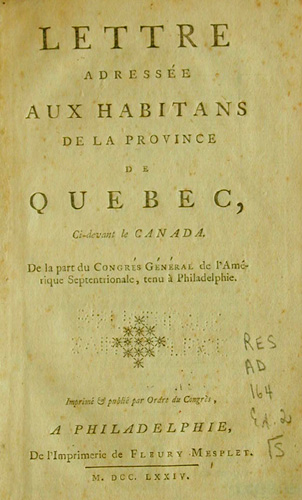
The Letters to the inhabitants of Canada were three letters written by the First and Second Continental Congresses in 1774, 1775, and 1776 to communicate directly with the population of the Province of Quebec, formerly the French province of Canada, which had no representative system at the time. Their purpose was to draw the large French-speaking population to the American revolutionary cause. This goal ultimately failed, and Quebec, along with the other northern provinces of British America, remained loyal to Britain. The only significant assistance that was gained was the recruitment of two regiments totalling not more than 1,000 men.
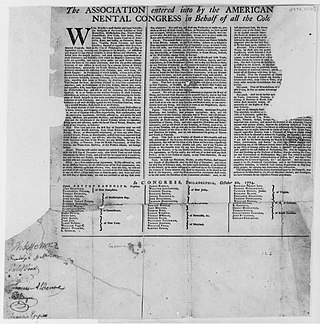
The Continental Association, also known as the Articles of Association or simply the Association, was an agreement among the American colonies adopted by the First Continental Congress in Philadelphia on October 20, 1774. It was a result of the escalating American Revolution and called for a trade boycott against British merchants by the colonies. Congress hoped that placing economic sanctions on British imports and exports would pressure Parliament into addressing the colonies' grievances, especially repealing the Intolerable Acts, which were strongly opposed by the colonies.

The committees of correspondence were a collection of American political organizations that sought to coordinate opposition to British Parliament and, later, support for American independence during the American Revolution. The brainchild of Samuel Adams, a Patriot from Boston, the committees sought to establish, through the writing of letters, an underground network of communication among Patriot leaders in the Thirteen Colonies. The committees were instrumental in setting up the First Continental Congress, which convened in Philadelphia in September and October 1774.

The Suffolk Resolves was a declaration made on September 9, 1774, by the leaders of Suffolk County, Massachusetts. The declaration rejected the Massachusetts Government Act and resulted in a boycott of imported goods from Britain unless the Intolerable Acts were repealed. The Resolves were recognized by statesman Edmund Burke as a major development in colonial animosity leading to adoption of the United States Declaration of Independence from the Kingdom of Great Britain in 1776, and he urged British conciliation with the American colonies, to little effect. The First Continental Congress endorsed the Resolves on September 17, 1774, and passed the similarly themed Continental Association on October 20, 1774.

The Restraining Acts of early 1775 were two Acts passed by the Parliament of Great Britain, which limited colonial trade in response to both increasing and spreading civil disobedience in Massachusetts and New England, and similar trade restrictions instituted by elected colonial representatives. With time the foment would spread to most of its American Colonies. The first restraining act, known variously as the New England Trade And Fisheries Act, the New England Restraining Act, or the Trade Act 1775, limited the export and import of any goods to and from only Great Britain, Ireland, and the British West Indies; it also prohibited the New England colonies from fishing in the waters off Newfoundland and most of America's Atlantic coast, without special permissions and documentation, and imposed stiff penalties on both perpetrators and administrators if violations occurred. Previously legal or finessed trade between the colonies themselves or with other nations was prohibited, and enforced by naval blockade, effective July 1, 1775. The second restraining act, known also as the Trade Act 1775, similarly limited the export or import of any goods by way of only Great Britain, Ireland, and the British West Indies for most colonies south of New England; it was passed shortly after the first, upon receiving news in April that the colony's trade boycott had spread widely among other colonies. New York, Delaware, North Carolina and Georgia would escape these restraints on trade, but only for a few months.

The Boston Tea Party was an American political and mercantile protest on December 16, 1773, by the Sons of Liberty in Boston in colonial Massachusetts. The target was the Tea Act of May 10, 1773, which allowed the British East India Company to sell tea from China in American colonies without paying taxes apart from those imposed by the Townshend Acts. The Sons of Liberty strongly opposed the taxes in the Townshend Act as a violation of their rights. In response, the Sons of Liberty, some disguised as Native Americans, destroyed an entire shipment of tea sent by the East India Company.
The Fairfax Resolves were a set of resolutions adopted by a committee in Fairfax County in the colony of Virginia on July 18, 1774, in the early stages of the American Revolution. Written at the behest of George Washington and others, they were authored primarily by George Mason. The resolutions rejected the British Parliament's claim of supreme authority over the American colonies. More than thirty counties in Virginia passed similar resolutions in 1774, "but the Fairfax Resolves were the most detailed, the most influential, and the most radical."
The Committee of Sixty or Committee of Observation was a committee of inspection formed in the City and County of New York, in 1775, by rebels to enforce the Continental Association, a boycott of British goods enacted by the First Continental Congress. It was the successor to the Committee of Fifty-one, which had originally called for the Congress to be held, and was replaced by the Committee of One Hundred.
The New York Provincial Congress (1775–1777) was a revolutionary provisional government formed by colonists in 1775, during the American Revolution, as a pro-American alternative to the more conservative New York General Assembly, and as a replacement for the Committee of One Hundred. The Fourth Provincial Congress, resolving itself as the Convention of Representatives of the State of New York, adopted the first Constitution of the State of New York on April 20, 1777.
The Provincial Congresses were extra-legal legislative bodies established in ten of the Thirteen Colonies early in the American Revolution. Some were referred to as congresses while others used different terms for a similar type body. These bodies were generally renamed or replaced with other bodies when the provinces declared themselves states.

The Massachusetts Provincial Congress (1774–1780) was a provisional government created in the Province of Massachusetts Bay early in the American Revolution. Based on the terms of the colonial charter, it exercised de facto control over the rebellious portions of the province, and after the British withdrawal from Boston in March 1776, the entire province. When Massachusetts Bay declared its independence in 1776, the Congress continued to govern under this arrangement for several years. Increasing calls for constitutional change led to a failed proposal for a constitution produced by the Congress in 1778, and then a successful constitutional convention that produced a constitution for the state in 1780. The Provincial Congress came to an end with elections in October 1780.

The Declaration and Resolves of the First Continental Congress was a statement adopted by the First Continental Congress on October 14, 1774, in response to the Intolerable Acts passed by the British Parliament. The Declaration outlined colonial objections to the Intolerable Acts, listed a colonial bill of rights, and provided a detailed list of grievances. It was similar to the Declaration of Rights and Grievances, passed by the Stamp Act Congress a decade earlier.

The Petition to the King was a petition sent to King George III by the First Continental Congress in 1774, calling for the repeal of the Intolerable Acts. The King's rejection of the Petition, was one of the causes of the later United States Declaration of Independence and American Revolutionary War. The Continental Congress had hoped to resolve conflict without a war.

The Edenton Tea Party was a political protest in Edenton, North Carolina, in response to the Tea Act, passed by the British Parliament in 1773. Inspired by the Boston Tea Party and the calls for tea boycotts and the resolutions of the first North Carolina Provincial Congress, 51 women, led by Penelope Barker, met on October 25, 1774, and signed a statement of protest vowing to give up tea and boycott other British products "until such time that all acts which tend to enslave our Native country shall be repealed." The boycott was one of the events that led up to the American Revolution (1775–1781). It was the "first recorded women's political demonstration in America".
The First North Carolina Provincial Congress was the first of five extra-legal unicameral bodies that met beginning in the summer of 1774. They were modeled after the colonial lower house. These congresses created a government structure, issued bills of credit to pay for the movement, and organized an army for defense, in preparation for the state of North Carolina. This First Congress met in New Bern from August 25 to August 27, 1774. John Harvey served as president. These Provincial congresses paved the way for the first meeting of the North Carolina General Assembly on April 7, 1777 in New Bern, North Carolina.

